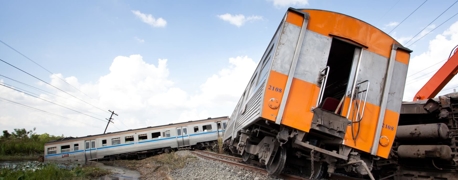Are Trucks Required to Stop at Railroad Crossings?

Driving on the road is an everyday event for many individuals throughout the country, whether they are driving to work, driving for work, or using some type of public transportation such as a bus or train. Many people have witnessed firsthand many buses and trucks stopping at railroad crossings before going over the tracks. You might be wondering why some trucks and buses stop before railroad tracks. We explain the laws in the rest of the post!
Understanding what vehicles must stop at all railroad crossings can help you get a clear picture of who may be at fault in such an accident, and what you can do to get help if you've been injured or have lost someone you love.
What Vehicles Must Stop at All Railroad Crossings?
According to Subpart B, 392.10, if a commercial vehicle is transporting passengers, such as in the case of a bus, the vehicle is required to stop before crossing over the railroad tracks within 50 feet of the track but no closer than 15 feet to look and listen for an approaching train. This rule is designed to protect bus passengers and drivers.
The other types of vehicles that must stop include:
- A truck carrying any quantity of Division 2.3 chlorine, hazardous material as defined in the Hazardous Materials Regulations of the United States Department of Transportation (DOT) must stop at railroad crossings
- A truck carrying any cargo with a temperature above its flashpoint must stop at railroad crossings
- A truck that is required to be marked with certain placards must stop at railroad crossings
What Dangers Make Trucks Susceptible to Accidents?
It is important for trucks to take extra precautions for several reasons. These vehicles are obviously very large. In fact, a fully-loaded big rig can weigh as much as 40 tons (80,000 pounds)! These vehicles can also extend four to five times the length of a regular passenger car.
Because of their size and weight, fully loaded commercial vehicles take much longer to come to a full stop than conventional cars. Their brakes have to work that much harder to bring all that mass to a stop. For comparison purposes, a typical passenger car usually can stop within about 130 to 140 feet when traveling at 55 miles per hour. At that same speed, a loaded commercial truck would require 190 to 200 feet to make a stop, or even 450 feet if it has hot brakes from frequent use.
Not only that, but the loud noise caused by powerful truck engines can block out the sounds of an oncoming train that would alert the driver of a smaller and quieter vehicle. For these reasons and more, it is important for the drivers of certain commercial trucks to take extra caution to avoid truck-train accidents by planning for a full stop at all railway crossings, and looking both ways to scan the tracks before continuing.
Schedule a Free Case Consultation with Our Team
If you were involved in an accident caused by a truck driver who failed to properly stop at a railroad crossing, it is very important that you learn about your options. We encourage you to immediately speak with a truck accident lawyer from Arnold & Itkin. Your rights to pursue compensation are important, and there is a time limit on truck accident cases, so do not hesitate to take the next step.
Need counsel? Contact a truck accident attorney from our firm today.
- Categories

